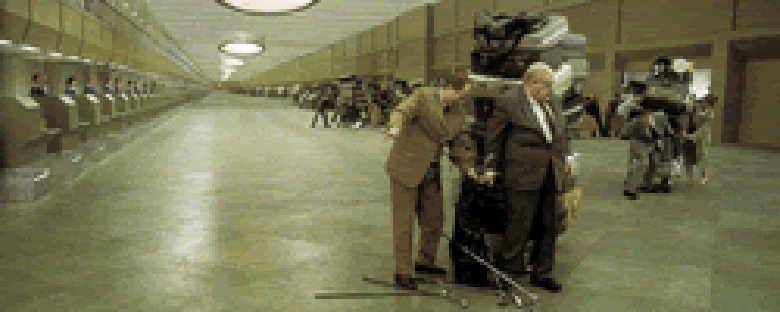Reviews
Sånger Från Andra Våningen
Roy Andersson
Sweden, 2000
Credits
Review by Leo Goldsmith
Posted on 11 July 2004
Source New Yorker Video DVD
Millennial anxiety may be out of fashion, but Roy Andersson’s hilariously disconcerting Songs from the Second Floor presents a vision of the year 2000 that avoids both paranoia and cliché. Perhaps this is because, in Andersson’s uneasy world, the turn of the millennium comes not with a bang, but a whimper — the world is spared any sort of violent techno-social catastrophe, but all of humanity must nonetheless live up to its failures and fragilities. Or as the film’s symbolism has it, we are not speeding towards the edge of a cliff, but rather stuck in interminable gridlock.
Each of the film’s scenes emphasizes this sense of being stuck. There is a traffic jam, which snakes through the film without explanation; the oppressive waiting room of a bus station; a massive airport in which travelers labor to move their massive cartloads of luggage and golf-clubs only a few yards; and a train station where figures from the past rise from the dead to torment the living. In each of these episodes Andersson’s camera is impassive. There is a total of forty-six shots in the film, each of which (with one notable exception) is a static, wide-angle composition that frames an entire episode. This cinematography effectively isolates the film’s hapless characters, enclosing them in the expansive, colorless surroundings and observing them with a remote, seemingly pitiless gaze.
But while the camera observes these restless souls dispassionately, Andersson’s empathy for his subjects is implicit. His menagerie of hopeless characters stand in for every type of social ill, institutional injustice, and human weakness: an immigrant who is brutally attacked while bystanders passively look on; a magician who bungles his trick of sawing a man in half; a young girl who is sentenced to a bizarre sacrifice by a tribunal of her elders; a routinely unsuccessful crucifix salesman. But the film also locates a measure of hope, especially in the character of the crucifix salesman’s son, who has gone insane from reading too much poetry (shades of Ordet). His pitiable, taciturn presence represents a glimmer of beauty in this grey, oppressively consumerist world. His mixture of hopefulness and pathos is given voice by the film’s elegantly mournful score (written by ABBA’s Benny Andersson) and by a repeated line from a poem by César Vallejo: “Beloved is the one who sits down.”
Songs from the Second Floor’s strongest aspect is its extraordinarily precise mise-en-scène, a tribute to Roy Andersson’s perfectionism and sense of comic (and tragic) timing. And while the film bears the mark of a number of cinematic influences (the traffic jam in Fellini’s 8 1/2, the absurdity of Monty Python, the similarly overpowering architecture in Gilliam’s Brazil), Andersson’s film offers a distinctive view of modern unease with restrained sympathy. And with its defiantly irresoluble conclusion — an ambiguous Second Coming on a trash heap — it leaves its viewer with a sense of uncertainty that is perhaps all too familiar.
We don’t do comments anymore, but you may contact us here or find us on Twitter or Facebook.



